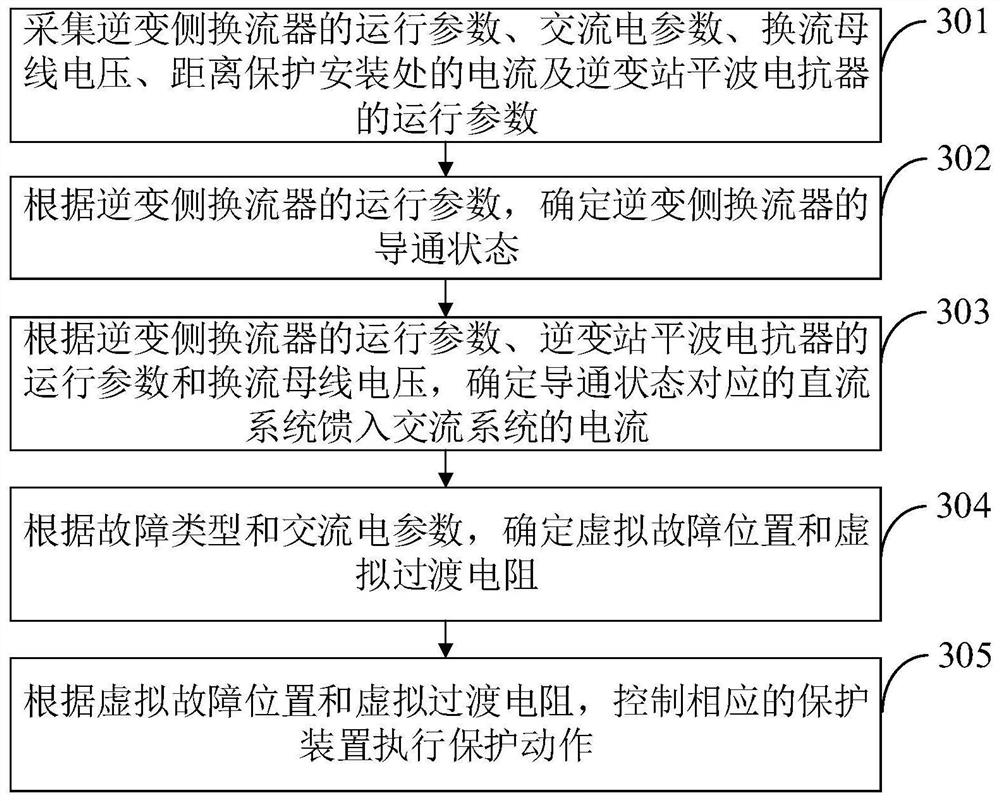A method and system for distance protection of AC lines in an AC-DC hybrid power grid
An AC-DC hybrid, distance protection technology, applied in AC network circuits, power transmission AC networks, circuit devices, etc., can solve the problems of DC system commutation failure, refusal, and traditional distance protection misoperation, etc., to improve accuracy. the effect of reducing the chance of refusal or accidental movement
- Summary
- Abstract
- Description
- Claims
- Application Information
AI Technical Summary
Problems solved by technology
Method used
Image
Examples
Embodiment 1
[0149] The A-phase grounding fault and the AB two-phase grounding fault are respectively set at 50% of the AC line, and the transition resistance varies from 0 to 300Ω.
[0150] When there is no fault in the AC / DC hybrid grid, such as figure 2 Both the Y-bridge inverter and the D-bridge inverter shown are normally commutated. At t=0ms, the Y-bridge converter is in the conduction state of VTY1 and VTY2, and the D-bridge converter is in the conduction state of VTD1 and VTD2. Under the action of the trigger signal of the Y-bridge converter VTY3 and the D-bridge converter VTD3 , the Y-bridge converter and the D-bridge converter are commutated successively. When the voltage of the D-bridge converter VTD1 changes from negative to positive for the first time and its blocking capability is restored, the Y-bridge converter and the D-bridge converter commutate. The inverter completes commutation. At this time, the Y-bridge inverter is in the conduction state of VTY2 and VTY3, and the ...
Embodiment 2
[0159] The A-phase grounding fault and the AB-phase-to-phase fault are respectively set at different positions in the AC line area. When the A-phase grounding fault occurs, the transition resistance is 300Ω.
[0160] At t=0ms, the Y-bridge converter is in the conduction state of VTY1 and VTY2, and the D-bridge converter is in the conduction state of VTD1 and VTD2. Under the action of the trigger signal of the Y-bridge converter VTY3 and the D-bridge converter VTD3 , the Y-bridge converter and the D-bridge converter are commutated successively. When the voltage of the D-bridge converter VTD1 changes from negative to positive for the first time, the conduction states of the Y-bridge converter and the D-bridge converter are as follows: Table 2 shows:
[0161] Table 2 The conduction state of the converter when the A-phase ground fault and the AB-phase-to-phase fault occur at different positions of the AC line
[0162]
[0163] It can be seen from Table 2 that when an AB phase-...
Embodiment 3
[0168] exist figure 2 The ground fault of phase A is set at f1 in the middle, and the variation range of the transition resistance is 0~300Ω.
[0169] At t=0ms, the Y-bridge converter is in the conduction state of VTY1 and VTY2, and the D-bridge converter is in the conduction state of VTD1 and VTD2. Under the action of the trigger signal of the Y-bridge converter VTY3 and the D-bridge converter VTD3 , the Y-bridge converter and the D-bridge converter are commutated successively. When the voltage of the D-bridge converter VTD1 changes from negative to positive for the first time, the conduction states of the Y-bridge converter and the D-bridge converter are as follows: Table 3 shows:
[0170] Table 3 The conduction state of the converter when the DC system on the back side of the AC line fails
[0171]
[0172]
[0173] It can be seen from Table 3 that when the transition resistance is 0Ω, the Y-bridge converter VTY1 fails to restore the blocking capability during the ...
PUM
 Login to View More
Login to View More Abstract
Description
Claims
Application Information
 Login to View More
Login to View More - R&D
- Intellectual Property
- Life Sciences
- Materials
- Tech Scout
- Unparalleled Data Quality
- Higher Quality Content
- 60% Fewer Hallucinations
Browse by: Latest US Patents, China's latest patents, Technical Efficacy Thesaurus, Application Domain, Technology Topic, Popular Technical Reports.
© 2025 PatSnap. All rights reserved.Legal|Privacy policy|Modern Slavery Act Transparency Statement|Sitemap|About US| Contact US: help@patsnap.com



